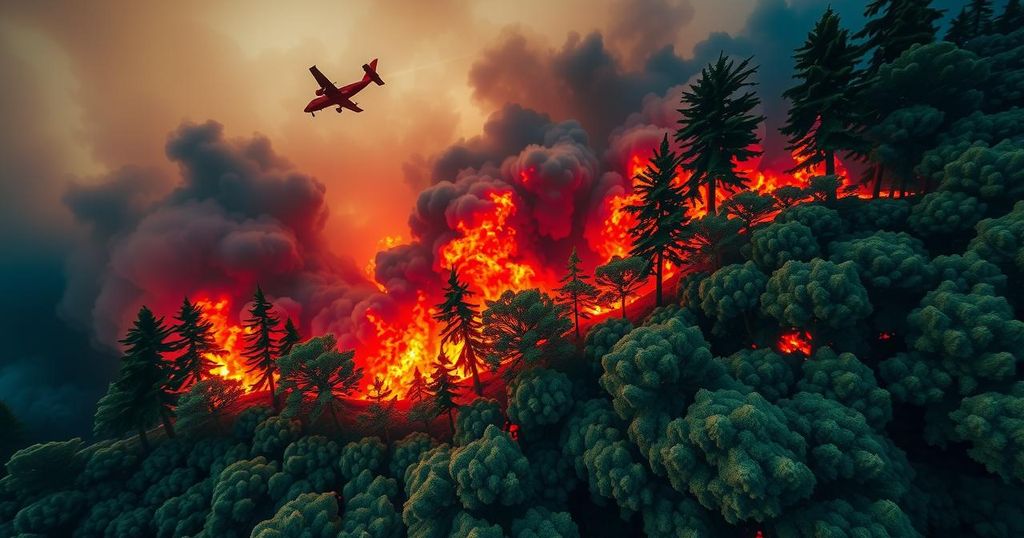The Impact of Santa Ana Winds on California’s Wildfires
The Santa Ana winds significantly enhance wildfire risks in Southern California, worsening with climate change. Their mechanics involve dry air and high winds that create fire-friendly conditions. History shows a strong link between these winds and major wildfires, challenging fire management efforts and necessitating advanced technology and strategies for community safety.
The Santa Ana winds, strong and dry winds that occur in Southern California, significantly contribute to the acceleration of wildfires in the region. Their intensity and direction make them crucial factors during major fire events, including the recent Pacific Palisades fire, which is among the most destructive in Los Angeles history. As climate change intensifies, the effects of these winds exacerbate fire risks, thus mandating advanced fire management strategies to protect communities.
The mechanics of the Santa Ana winds involve high-pressure systems that drive air from the interior towards the coast. This process, also known as adiabatic heating, leads to extremely low humidity levels, often below 10%, rendering vegetation highly flammable. With gusts potentially reaching speeds of 100 km/h, these winds not only facilitate the rapid spread of flames but also hinder firefighting efforts.
Climate change has been identified as a key factor fueling conditions that lead to wildfire outbreaks, further complicating the impact of the Santa Ana winds. Rising temperatures, diminished snow cover, and prolonged periods of drought are transforming the landscape into a hotbed for fires. In California, the land burned by wildfires during summer has increased fivefold from 1996 to 2021, primarily due to drier vegetation rather than shifts in wind patterns.
Historically, the Santa Ana winds have played a pivotal role in shaping Southern California’s environment and fire history. Documentation from indigenous cultures and Spanish colonial records highlights their long-standing presence in the region. Notable wildfires, such as the Bel Air Fire of 1961 and the Cedar Fire of 2003, exemplify the adverse effects these winds have had on fire incidents throughout California’s history.
The explosive nature of the Santa Ana winds creates significant challenges for fire management in California. Their capacity for rapid fire spread and their unpredictable shifts in direction complicate containment efforts, as evidenced by the Pacific Palisades fire that resulted in over 1,000 structures being destroyed. Additionally, urban infrastructure faces vulnerabilities during mass evacuations, emphasizing the necessity for improved fire management strategies and advanced monitoring systems.
Technological advancements are becoming instrumental in addressing wildfires driven by the Santa Ana winds. Drones equipped with thermal imaging cameras provide real-time surveillance of fire activity, particularly in hard-to-access areas. Coupling this with artificial intelligence-driven predictive models enhances the ability to manage firefighting resources effectively. Furthermore, the integration of advanced early warning systems fosters swift community responses to imminent dangers.
To effectively mitigate the risks posed by Santa Ana winds, a comprehensive approach is essential. This should include climate adaptation measures, resource management, and community education. Implementing reforestation efforts, preventive vegetation management, and fire-resistant urban planning will significantly diminish wildfire impacts. Additionally, collaboration amongst scientists, urban planners, and emergency services is vital in devising technologies to accurately predict wind behavior.
As California faces increasingly extreme climates, preparedness for the Santa Ana winds becomes crucial to safeguarding lives and preserving communities. Understanding these winds’ dynamics can create more resilient strategies to tackle future wildfire threats, ensuring comprehensive protection for all Californians.
The Santa Ana winds are a crucial factor in Southern California’s wildfire dynamics. This recurring meteorological phenomenon has a long history, documented by native traditions and colonial records, demonstrating a consistent relationship with major fire outbreaks in the region. Understanding the mechanics and implications of these winds has become increasingly important as climate change exacerbates wildfire conditions, leading to more frequent and intense fire events.
In summary, the Santa Ana winds serve as a significant catalyst for California’s wildfires, particularly in the context of climate change. Their ability to transform vegetation into highly flammable material and expedite fire spread presents challenges for emergency responders and necessitates advanced strategies for fire management. A multi-faceted approach, leveraging technological innovations alongside community preparedness and collaboration, is vital to mitigate the destructive impacts of these winds.
Original Source: www.drivingeco.com




Post Comment